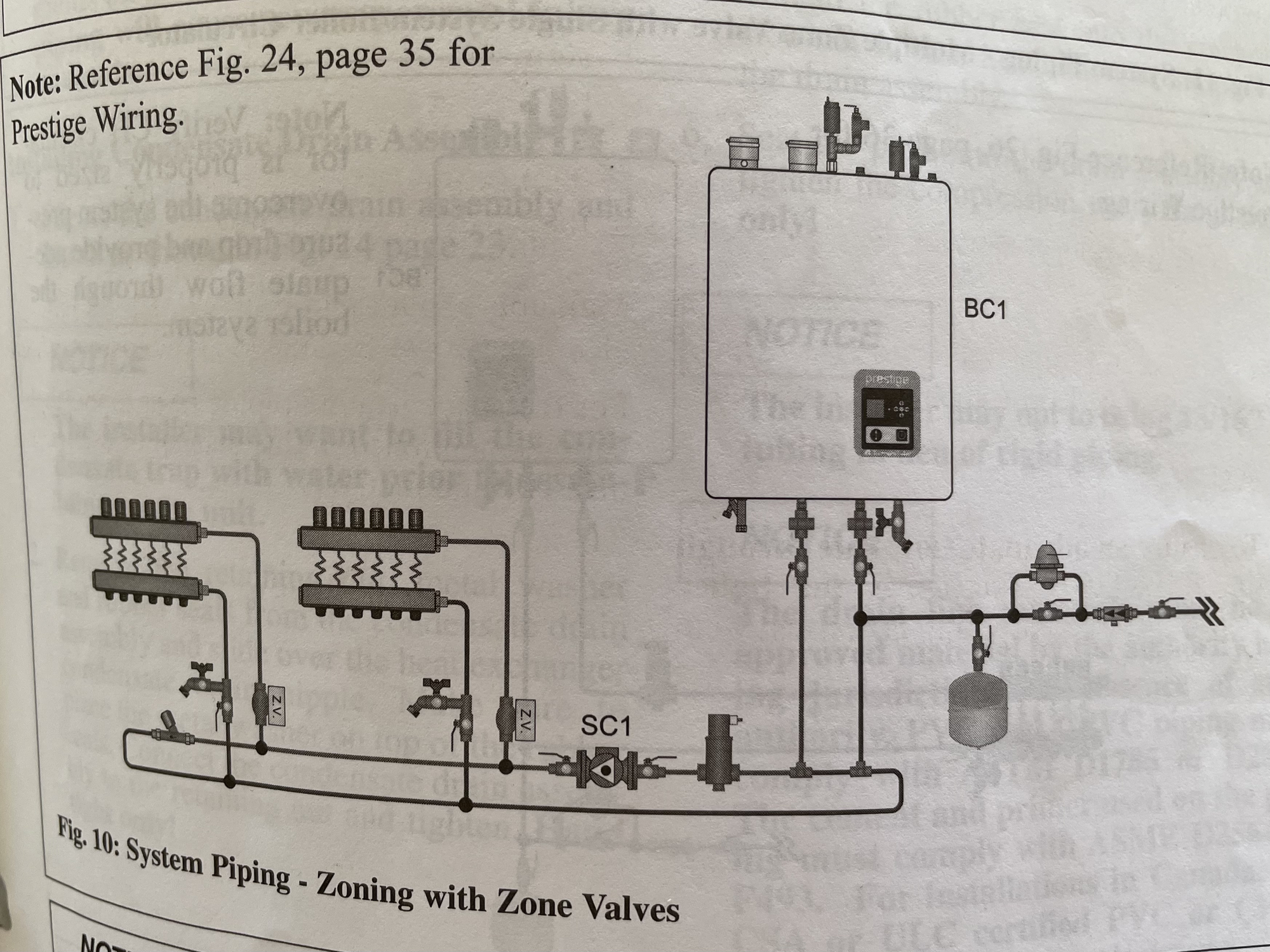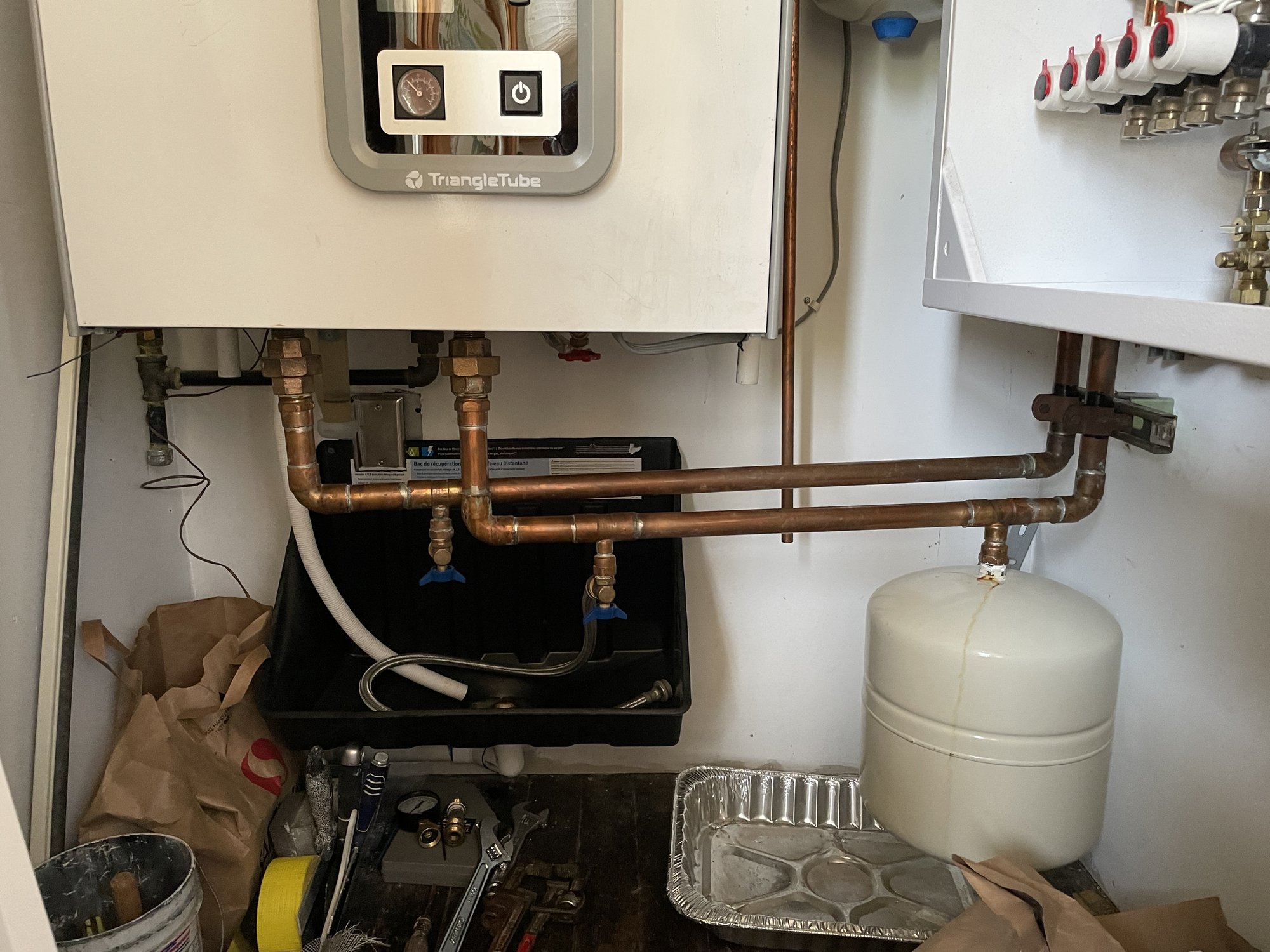Welcome! Here are the website rules, as well as some tips for using this forum.
Need to contact us? Visit https://heatinghelp.com/contact-us/.
Click here to Find a Contractor in your area.
If our community has helped you, please consider making a contribution to support this website. Thanks!
Combo boiler expansion tank question
Options
Timpy
Member Posts: 4
Hello all
not a professional but I have replaced an oil boiler with a gas condensing unit with the help of a plumber friend and I do maintenance and repair on a one pipe steam system at an apartment building I own.
not a professional but I have replaced an oil boiler with a gas condensing unit with the help of a plumber friend and I do maintenance and repair on a one pipe steam system at an apartment building I own.
I have a Triangle Tube Prestige Excellence 110 combo heat and dhw boiler which is connected to a Danfoss pump panel. The Danfoss is set up like the Pumping Away heating module with a circulator, 5 zones and a fill/ air eliminator with a fitting for the expansion tank to thread into. I am currently just using the dhw side of the boiler and will be adding the central heat this fall.
The problem I was having was that the Triangle tube needs the expansion tank to be on the return side of the boiler so the system pressure doesn’t get too high when the boiler is having a dhw call and pop the tpr valve. I spliced the tank into the return side and that problem went away.
Now that I am going to be activating the panel and adding central heat I am thinking I will need the expansion tank to be on the supply side so I can pump away from it. Am I correct? Can I run 2 expansion tanks? Or can I just leave it where it is?
Now that I am going to be activating the panel and adding central heat I am thinking I will need the expansion tank to be on the supply side so I can pump away from it. Am I correct? Can I run 2 expansion tanks? Or can I just leave it where it is?
The only difference I can see in my piping to the Triangle Tube diagram is that I don’t have the two closely spaced Tees between supply and return (just below the boiler in the diagram). If I add this will that provide the dhw circuit access to the expansion tank if I were to move it back? I was assuming this was taken care of in the panel. I believe it has a bypass.
Thanks for any help or ideas
Tim Purtill Seattle WA


Thanks for any help or ideas
Tim Purtill Seattle WA



0
Comments
-
Is there any sort of check valve or backflow preventer or pressure reducer on the domestic side? Is this city water or a well? If it is a well or there is any sort of check on the domestic side, then you absolutely have to have an expansion tank on the domestic hot water. That one should be set to whatever your domestic water pressure is.
In any case, you have to have one on the heating side, and that one should be piped so you are pumping away from it, and it should be set to your system static pressure -- probably 12 to 15 psi. If it's set so you are pumping away, and your system static pressure is as I say 12 to 15 psi, unless you have an absolute gorilla of a pump you'll not reach more than 20 psi or so on the outlet of the pump -- and hence the boiler -- and it should be just fine.Br. Jamie, osb
Building superintendent/caretaker, 7200 sq. ft. historic house museum with dependencies in New England0 -
How are you mating this HW boiler to a Singe pipe Steam System?0
-
-
@pecmsg
The steam is in a different building.
@Timpy
If the T & P valve on the water heater side of things opened you going to need two expansion tanks, 1 for the heating side piped like the drawing above and one for the domestic side. You have four boiler connections 2 for heat and 2 for the dhw. The water from those two systems never touch 1 is boiler water 1 is potable water.
Keep in mind the expansion tanks for potable water and the one for boiler water are built for different purposes and different pressures. Make sure they are pressureized properly before installing0 -
This is city water and there is a mixing valve, a check valve and an expansion tank on the dhw similar to the attached diagram. I can’t have two on the heat loop can I?I know the tank on the heat loop will probably work where it is but I was hoping I could get it on the supply side so I could pump away from it and avoid bleeding radiators
 as much etc. also it is now not able to be at the system fill point.
as much etc. also it is now not able to be at the system fill point.
The space for the expansion tank on the zone panel is to the right of and below the yellow tag in the picture from my original post. It connects to the air separator which seems like the ideal place for it.0 -
Look. The tank you are showing in the diagram above is for the domestic hot water. You also must have a tank on the heating water loop, after any pressure reducing valve or automatic feed valve or whatever. It would be best if you could pipe that one in before the circulating water pump, but whatever -- you have to have one there.
I have an uneasy feeling that you are not quite clear in your mind as to which pipes are domestic hot water and which pipes are heating...Br. Jamie, osb
Building superintendent/caretaker, 7200 sq. ft. historic house museum with dependencies in New England0 -
The first photo shows the expansion tank on the heating loop. That is the one I had the question about.I showed the other loop in response to the comment by @EBEBRATT-Ed.0
-
I am concerned that there are 2 circulators on a single dh loop. It looks like the manual shows it pipes primary-secondary and it appears to be piped as a single loop in the picture.0
-
Sorry the picture may be unclear. The Dhw loop is internal to the boiler. This is a combo boiler with a small infernal holding tank for potable water. What is shown in the second drawing is the external piping to the mixing valve and then to fixtures.My CH piping only similar to the first drawing because as I mentioned I have the zone panel. I think what is confusing is that the dhw is not shown on the first drawing. I included the first drawing to illustrate my question about the close spaced tees as shown directly under the boiler in the drawing.0
-
You shouldn't have to bleed air out of the radiators unless you drained some water from the heating system and it sucked in air. Modern expansion tanks don't introduce air, the bladder keeps the air and and water from mixing. So you would need one ET for the heating loop and one for the DHW loop. I don't think the placement is critically important. Most of the pressure comes from the water expanding as it heats, not from the pressure from the circulators.
Note: I'm not a plumber or hvac man and my thoughts in comments are purely for conversation.I'm not a plumber or hvac man and my thoughts in comments are purely for conversation.0
Categories
- All Categories
- 87.3K THE MAIN WALL
- 3.2K A-C, Heat Pumps & Refrigeration
- 61 Biomass
- 429 Carbon Monoxide Awareness
- 120 Chimneys & Flues
- 2.1K Domestic Hot Water
- 5.8K Gas Heating
- 114 Geothermal
- 166 Indoor-Air Quality
- 3.7K Oil Heating
- 77 Pipe Deterioration
- 1K Plumbing
- 6.5K Radiant Heating
- 395 Solar
- 15.7K Strictly Steam
- 3.4K Thermostats and Controls
- 56 Water Quality
- 51 Industry Classes
- 50 Job Opportunities
- 18 Recall Announcements

